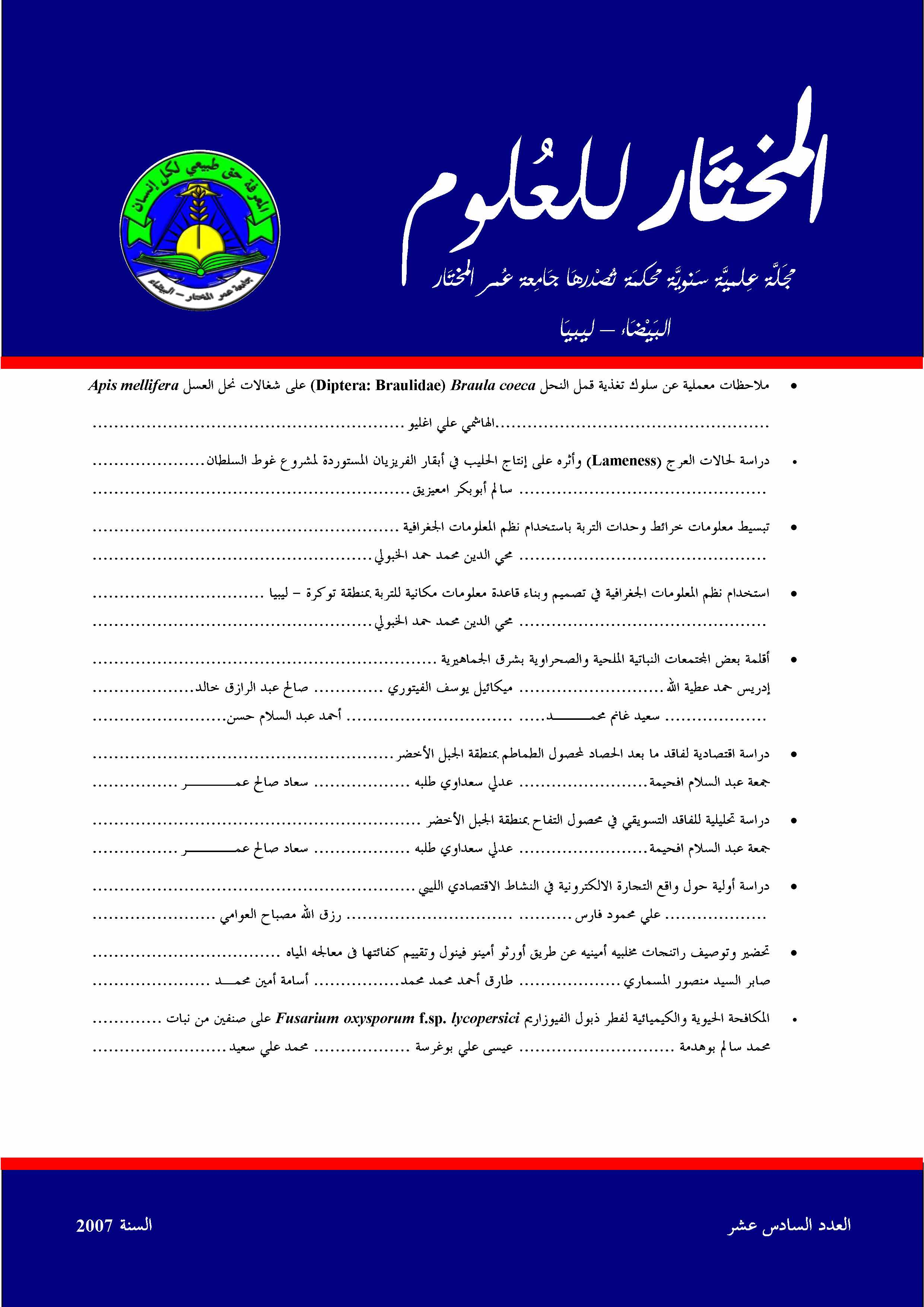Adaptation of some plant communities in and Halophytes in East Libya Xerophytes
DOI:
https://doi.org/10.54172/mjsc.v16i1.871Keywords:
Adaptation, plant communities, Halophytes, East Libya, XerophytesAbstract
The diversity of plant communities in two extreme ecological areas namely: Ardisols (El-Mekhely) and salt affected soil (Sabkha-Benghazi) was studied during the rain season. The Ardisols was characterized by low electrical conductivity, and total soluble salts as well as little water availability in comparison to salt affected soils. About xerophytes, ten species were adapted in Ardisols of which: Zilla spinos, Lycium euroeabaeum, Carrichtera malacoide, Aizoon hispunieum, Emax spinosus, Sisymbrium irio, Fagonia cretica, Capparis spinosa, Euphorbia carnuta. On the other hand, twelve species were adapted in salt affected soils, six of them belonging to family Chenopodiaceae; Halocnemun strobilaceum, Arthronemon glancum, Atriplex glancum, Halopopli amplexicaulics, Salicornia fruticosa, Suaeda pruinosa, well known family for its capacity as a tolerance to salt environments. Moreever, the rest families represented as one species each.
Downloads
References
بن محمود خالد رمضان . 1995 . الترب الليبية ، تكوينها وتصنيفها وخواصها وإمكانياتها الزراعية . الهيئة القومية للبحث العلمي ، طرابلس ، ليبيا .
سالم الزوام ، 1984 . الجبل الأخضر . دراسة في الجغرافية الطبيعية . المنشأة العامة للنشر والتوزيع والإعلان, طرابلس ، ليبيا .
مجاهد أحمد محمد ، أمين عبدالرحمن ، الباز أحمد وعبدالعزيز مصطفى . 1990 . علم البيئة النباتية . مكتبة الانجلو المصرية-القاهرة ، مصر .
رياض . ع. أحمد . 1984 . الماء فى حياة النبات . مطابع جامعة الموصل ، مديرية مطبعة الجامعة ، الموصل ، العراق .
Anonymous, 1970. Salt injury to roadside plantings studied. Shade Tree. 43: 112.
Bernestein, L. 1964. Salt tolerance of plants. USDA Agr. Inf. Bull. No. 283. 23p.
Bohn, H.L., McNeal, R.L. and O’Conner, G.A. 1985. Soil Chemistry. 2nd ed. John Wiley, New York.
Driessen,P.M. and Dudal R. (eds), 1991. The major soils of the world, lecture notes on their geography, formation, properties and use. Zutphen, the Netherlands.
El-Galaly, M.A. 1993. Taxonomic studies of some genera of Chenopodiaceae in Egypt. MSc. Thesis. Faculty of Science, Zagazig University, Banha Branch. pp. 192.
El-Mahi, Y.E., Hussein, A.A., El-Amine, E.A, and Ibrahim, I.S. 1999. Salinity and sodicity effects on boron retention. Commun. Soil Sci. Plant Anal. 30: 2197–2209.
Faituri, M.Y., El-Hassan, G.A., and El-Mahi, Y.E. 1996. Effect of salinity and sodicity on bacterial-plant symbiotic relationship. Mukh. J. Sci. (Libya), 3: 112–128.
Faituri, M.Y., El-Mahi, Y.E., and El-Hassan, G.A. 2001. Effects of some salts and sodicity on the growth of a Rhizobium strain bv. Viceae strain isolated from a salt affected soil. Can. J. Microbiol. 47: 807–812.
Greenway, H., and Munns, R. 1980. Mechanism of salt tolerance in non-halophytes. Annul Rev. Plant Physiology 31: 149–190.
Hasegawa, P.M. and Bressan, R.A., and Handa, A.K. 1986. Cellular mechanisms of salinity tolerance. Hort. Sci. 21: 1317–1324.
Jafri, S.M.H. and El-Gadi, A. 1977. Flora of Libya. Al-Faateh University, Faculty of Science, Department of Botany, Tripoli, Libya.
Jenney, H. 1941. Factors of soil formation. McGrow-Hill. New York.
Le Houerou par H.N. 1984. An outline of the bioclimatology of Libya Bulletin de la sctete botanique de France. Actualites botanique, 131, (1/2/3/4), 157–178.
Nortcliff, S. 1988. Soil formation and characteristics of soil profiles. In: Wild A. (ed.), Russell's Soil Conditions and Plant Growth. 11th edition, London, UK
Page, A.L., Miller, R.H., and Keeny, R. 1982. Methods of soil analysis. Part 2. Chemical and Microbiological Properties. Agronomy Monograph no. 9. ASA. Madison, Wisconsin, USA.
Paul E.A. and Clark F.E. 1989. Soil Microbiology and Biochemistry. Academic Press, Inc.
Safa, S.A. 1992. Taxonomic studies in the Chenopodiacae of Egypt. PhD. Thesis, Faculty of Science. Al-Azhar University. Girls’ Branch.
Selkhozprom Expor. Soil Ecological Expedition. USSR. 1980. Soil studies in the western zone, the eastern zone and the pasture zone of the S.P.L.A.J. Secretariat of Agr. Reclamation and Land Development. Tripoli, Libya.
Soil Survey Staff. 1998. Soil Taxonomy: A basic system of soil classification for making and interpreting soil. 2nd ed. (Washington, D.C. USDA Natural Recourses conservation service) No. 436.
Täckholm, V. 1974. Students’ Flora of Egypt.
Boulos, L. 2002. Flora of Egypt. Al-Hadara, Cario, Egypt.
Wild, A. 1995. Soil and the Environment. Cambridge University Press, UK.
Zonn, S.V. and Kochubey M.I. 1978. Soil formation and soil of the Mediterranean coastal belt of Libya. Pochvovedenye, 12: 19–32.
Downloads
Published
How to Cite
License
Copyright (c) 2022 Ederees H. Atet Allah, Mikhail Y. Alfitory, Saleh A. Khaled, Saeed K. Mohammed , Ahmad A. Hasan

This work is licensed under a Creative Commons Attribution-NonCommercial 4.0 International License.
Copyright of the articles Published by Almukhtar Journal of Science (MJSc) is retained by the author(s), who grant MJSc a license to publish the article. Authors also grant any third party the right to use the article freely as long as its integrity is maintained and its original authors and cite MJSc as original publisher. Also they accept the article remains published by MJSc website (except in occasion of a retraction of the article).










